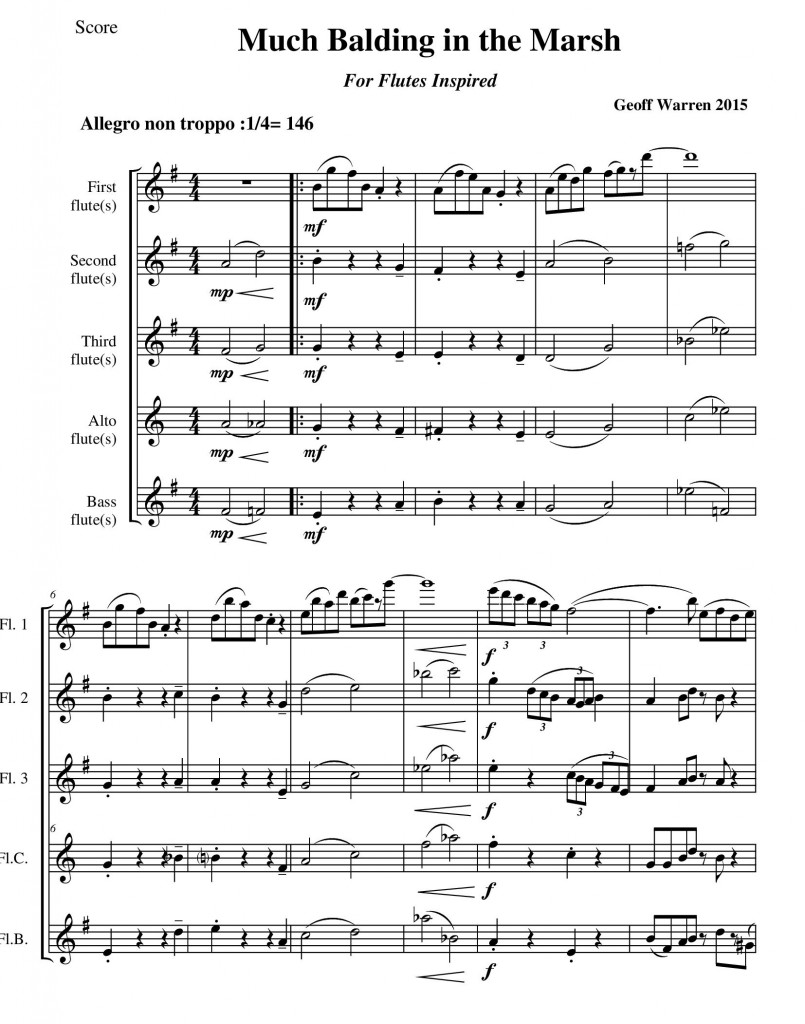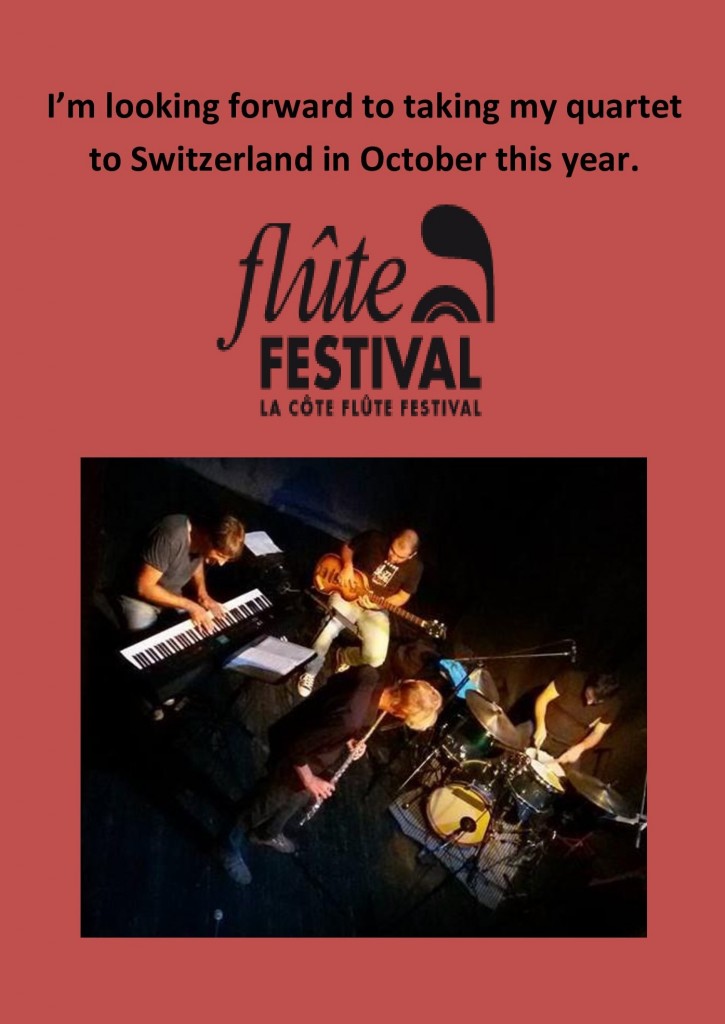Uncategorized: acid jazz diploma in flauto jazz ethno-jazz flauto jazz FMR Records Forton Music free sheet music downloads funky funky jazz funky jazz geoff warren groove indo jazz jazz flute Jazz flute music jazz flute summer school jazz flutemusic LAUREA IN FLAUTO JAZZ MatRecords Online lessons skype jazz flute lessons TUTU Records yamaha
by admin
leave a comment
Uncategorized: British Flute Society diploma in flauto jazz ethno-jazz flauto jazz flute fables flutes inspired FMR Records Forton Music funky funky jazz funky jazz groove jazz jazz education jazz flute Jazz flute music jazz flute summer school jazz flutemusic LAUREA IN FLAUTO JAZZ MatRecords Online lessons skype jazz flute lessons TUTU Records yamaha
by admin
leave a comment
New Publications
Currently in preparation: two new pieces for flute ensemble to be published by Forton Music. One of these, (opening page below) written for Flutes Inspired. For other pieces go to my Publications page (click above on the left.)
Uncategorized: blues flute diploma in flauto jazz ethno-jazz flauto jazz flute fables FMR Records funky funky jazz funky jazz geoff warren groove improvised jazz jazz education jazz flute Jazz flute music jazz flute summer school jazz flutemusic LAUREA IN FLAUTO JAZZ MatRecords Online lessons skype jazz flute lessons Trevor Taylor TUTU Records yamaha
by admin
leave a comment
Uncategorized: blues flute British Flute Society diploma in flauto jazz ethno-jazz flauto jazz flute fables FMR Records free sheet music downloads funky funky jazz geoff warren Geoff Warren Quartet groove indo jazz jazz education jazz flute jazz flute summer school jazz flutemusic La Côte Flûte Festival LAUREA IN FLAUTO JAZZ Marco Di Marzio Online lessons raffaele pallozzi skype jazz flute lessons TUTU Records walter caratelli yamaha
by admin
leave a comment
Uncategorized: afro jazz blues flute diploma in flauto jazz ethno-jazz flauto jazz flute fables FMR Records funky funky funky jazz funky jazz groove improvised jazz education jazz flute Jazz flute music jazz flute summer school jazz flutemusic LAUREA IN FLAUTO JAZZ MatRecords Online lessons skype jazz flute lessons yamaha
by admin
leave a comment
Uncategorized: diploma in flauto jazz ethno-jazz flauto jazz flute fables FMR Records Forton Music funky funky jazz funky jazz geoff warren groove improvised indo jazz jazz jazz education jazz flute Jazz flute music jazz flute summer school jazz flutemusic LAUREA IN FLAUTO JAZZ MatRecords Online lessons skype jazz flute lessons TUTU Records yamaha
by admin
leave a comment
Uncategorized: diploma in flauto jazz ethno-jazz flauto jazz flute fables FMR Records free sheet music downloads funky geoff warren improvised jazz jazz education jazz flute Jazz flute music jazz flute summer school jazz flutemusic LAUREA IN FLAUTO JAZZ MatRecords Online lessons skype jazz flute lessons TUTU Records yamaha
by admin
leave a comment
Uncategorized: accordo di settima maggiore diploma in flauto jazz ethno-jazz flauto jazz flute fables FMR Records funky funky funky jazz funky jazz geoff warren groove jazz jazz flute Jazz flute music jazz flute summer school jazz flutemusic LAUREA IN FLAUTO JAZZ lezioni online MatRecords Online lessons skype jazz flute lessons TUTU Records yamaha
by admin
leave a comment
MOMENTI DI PANICO – L’accordo di settima maggiore – maj7. (In English below)
L’accordo settima maggiore- Maj7 è un suono abbastanza stabile che comunica spesso un momento di arrivo o di risoluzione, piuttosto di avere un “tiro” verso un’altra armonia.
Quindi si trovo frequentemente come accordo finale di una sequenza e noi ci possiamo trovare con il compito di mettere un “fill” o piccola cadenza sopra.
In ogni caso ricordiamoci che la fondamentale verrà suonato dal basso e la nota che più definisce l’accordo , la settima maggiore, sarà probabilmente più in alto, forse anche in cima al voicing. Se noi solisti con uno strumento acuto e leggero come il flauto raddoppiamo la fondamentale l’effetto può essere debole e anche poco gradevole, quindi ci serva una soluzione che ci dia materiale motivico che sta bene con l’accordo senza utilizzare la nota fondamentale, che fatalmente sarà la prima nota che leggiamo quando suoniamo dallo spartito.
Conosci le pentatoniche?
Quelle maggiori?
Quelle minori?
SE NO, LE DEVI IMPARARE!
Quando vedi un accordo Maj7 usa la pentatonica maggiore che parte dalla quinta dell’accordo, o (stesse note) la pentatonica minore che parte dalla terza dell’accordo.
Es. Cmaj7 – usa la pentatonica di Sol maggiore (SOL è la quinta dell’accordo Cmaj7) o la pentatonica di MI minore (Mi è la terza dell’accordo Cmaj7)
Vorresti sapere perchè?
Vorresti sapere d più?
Contattami per lezioni flauto jazz su Skype.
Uncategorized: Accademia Flauto jazz diploma in flauto jazz ethno-jazz flute fables FMR Records funky funky jazz funky jazz geoff warren groove improvised jazz jazz education jazz flute Jazz flute music jazz flute summer school jazz flutemusic LAUREA IN FLAUTO JAZZ MatRecords Online lessons skype jazz flute lessons TUTU Records yamaha
by admin
leave a comment
PANIC MOMENTS – The Major Seventh Chord
The major seventh chord is a fairly stable sound, that often communicates arrival/resolution rather than having a “pull” towards another harmony.
So it is quite often the final chord in a sequence, and we can find ourselves with the job of perhaps adding a flourish or fill over it.
In any case the tricky thing about this chord is that the bass will play the root note and what defines the chord (the major seventh) will be higher up in the voicing, often right at the top.
If we, as a soloist playing a light, treble clef instrument like the flute, double the root note, the effect is limp, even unpleasant, so we need a solution that will give us motivic material that fits within the chord, without using that root note, which is fatally, the first note you read when playing through the music.
Do you know your pentatonics ?
Major pentatonics ?
Minor pentatonics ?
IF YOU DON’T, YOU SHOULD.
When you see a maj7 chord use the major pentatonic that starts out from the fifth of that chord.
Or (same notes), use the minor pentatonic that starts out from the third of the chord.
e.g. Cmaj7 – use a G major pentatonic (G is the fifth of the Cmaj7 chord)
or E minor pentatonic (E is the third of the C maj7 chord)
Want to know why?
Want to know more?
Contact me for skype jazz flute lessons.
Uncategorized: blues flute diploma in flauto jazz ethno-jazz flauto jazz FMR Records free sheet music downloads funky funky funky jazz improvised indo jazz jazz flute Jazz flute music jazz flute summer school jazz flutemusic LAUREA IN FLAUTO JAZZ Online lessons skype jazz flute lessons TUTU Records
by admin
leave a comment







